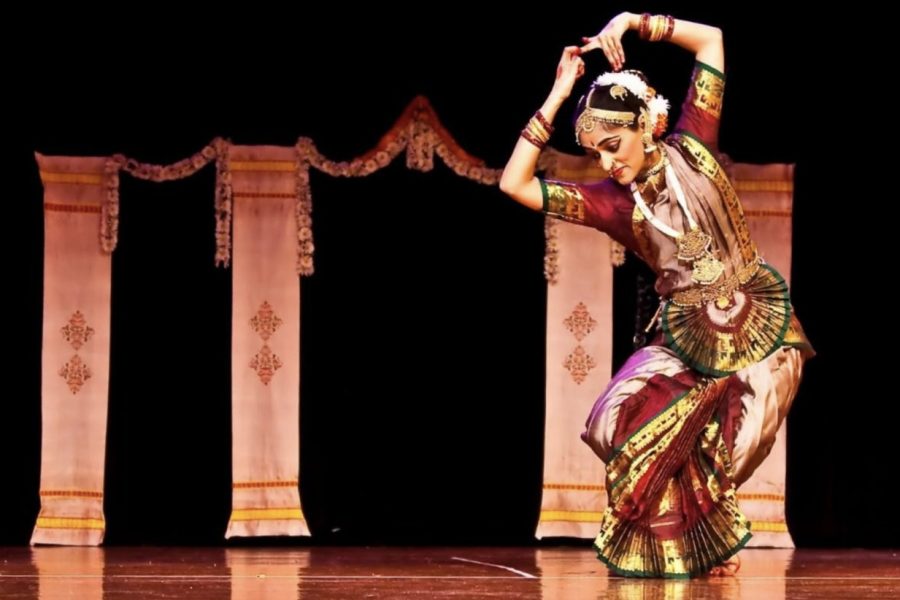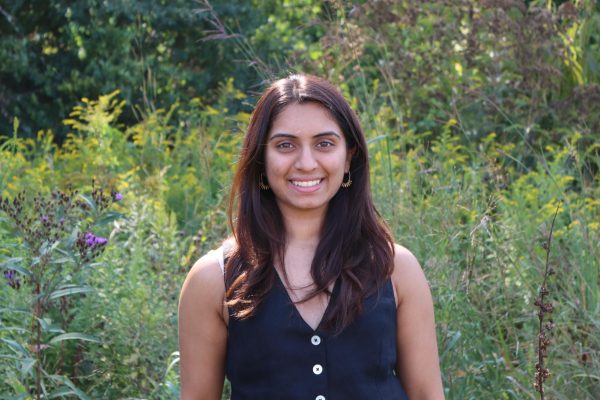Pallavi Nagesha: Spreading Indian culture through Bharatanatyam
Credit: Courtesy of Bhumika Arts
Dancer and teacher Pallavi Nagesha dances across the stage. As Nagesha teaches other and continues to grow herself, she hopes to expand the connection she has with Bharatnatyam. “Dance is a very personal experience, so each of the dancers has to get from it what they want, and I think the mind-body-soul connection is what I crave and I work towards,” Nagesha says.
January 10, 2023
The dancer takes a precise step in one direction. Her graceful hand movements depict nature and eyes hold expression. Each step is deliberate and driven by strength, carefully crafted and perfected through hours upon hours of practice. No words are said, but a story is being told with detail and emotion.
Dancer and Wayland Resident Pallavi Nagesha has been studying the challenging and rigorous Indian dance form of Bharatanatyam for almost 25 years, and has been teaching it for eight years. Nagesha grew up in the city of Hyderabad, India, and was first introduced to the Indian classical arts by listening to her mother’s singing. As a child, she enjoyed dancing around her house, though she never officially started her Bharatnatyam studies until the age of 24, after she came to the United States at age 21.
“One of the biggest challenges for me was that [I had] no family and no friends [when I moved to the United States],” Nagesha said. “I had to re-learn how to make friends. [There is a] very different culture [in America]. When I was in school, the learning culture was very different. The teaching culture was very different.”
She first started learning Bharatanatyam from friend and Bharatanatyam teacher Poornima Risbud in 1998, who taught in Canton, MA.
“[Risbud] was looking for people to dance, and so I volunteered [and I told her] ‘I can’t do classical because I haven’t learned formally, but I can do other things,’” Nagesha said. “Slowly, I was participating with her a lot.”
In 2014, Nagesha decided that she wanted to teach Bharatanatyam. She began to teach alongside Risbud, opening a new branch of the school in Wayland. Nagesha had already fostered a deep connection with Bharatanatyam in the first 15 years she learned it, and teaching only made her more devoted to the dance form.
“I wouldn’t call it a career, because for me it’s just an extension of me, and it’s an expression [of] what I feel [and] what I do,” Nagesha said. “Once I started to learn, and especially when I started to teach, it just became something that I poured my soul into. So it’s not a career for me, it’s just my way of life.”
Aside from Risbud, Nagesha has had other influential teachers that have guided her through her Bharatanatyam journey. Nagesha feels that she learns something new and valuable everytime she learns from them, and cherishes the lessons they have taught her. As a teacher herself, Nagesha believes that a teacher should be creative and supportive.
“No matter how hard it gets, you need someone that believes in you and picks you up when you’re down, and thinks outside the box,” Nagesha said.
Nagesha created her own dance school in 2018, Bhumika Arts, where she continues to spread her love for dance. Through her own experiences, Nagesha has created her own ways to interact and teach her students, some of which are influenced by her own teachers, and some of which she has figured out herself.
“I have a unique style of interacting with people, not just my students,” Nagesha said. “How I interact with others is very unique to me, but definitely how I choreograph [is influenced] by my teachers.”
Bharatanatyam is one of many Indian forms of dance. Some Bharatanatyam dances are focused solely on technicality and structure, while other, more advanced dances are abstract. These dances are usually derived from Hindu Mythology. In order to convey these stories without the usage of words, dancers must study the idols, landscapes and emotions they are supposed to embody. For Nagesha, this strengthened her understanding of Indian culture.
“Because I was studying this art form, I started to study a text called Natyashastra, and through that I started to study other scriptures,” Nagesha said. “So My Vedic learning really expanded to a greater degree after I started learning dance.”
Beyond intellectual learning, Bharatanatyam has taught Nagesha much on a spiritual level. Though she has been learning for over two decades, she believes she is still learning. Due to the dance form’s abstractness, one’s interpretation of dance is personal and unique. It is this abstractness that stems Nagesha’s love for dance.
“Dance is a connection of [the] mind and body,” Nagesha said. “It’s like a continuum that just keeps growing, and I think that’s the most fascinating thing for me [about dance]. There is movement, and there is stillness, and there is great meaning in this movement and stillness, and that fascinates me. There is no tangible thing that I can say dance has done [for me] because it continues to expand my knowledge, my human understanding and it continues to give me patience and compassion.”
In Wayland, Nagesha showcased Bharatanatyam to an audience unfamiliar with Indian culture through performances at places like the library and middle school. Through her performances, she has tried to educate people about Indian storytelling, and bridge the cultural gap.
“Everytime I have performed for a general audience, I have always catered to certain things,” Nagesha said. “I’ve thought a lot about what I am going to perform, and what I am going to say about the performance.”
Apart from educating through performances, Nagesha spreads Indian culture to her students, who come from various ethnic and religious backgrounds. Because of the different experiences of her students, she finds that the bond each dancer has with Bharatanatyam is different. However, she hopes all her students’ spiritual connection with the dance continues to expand.
“There is a connection between you and this universe,” Nagesha said. “Looking to expand this connection to the point where you don’t feel the difference between yourself and the universe is what spirituality is about, and dancing gives us that opportunity. For the few minutes that I am dancing, there is nothing else.”





![Last Wednesday, the Wayland School Committee gathered to discuss a number of topics regarding the health curriculum and Innovation Career Pathway course. Another large topic of conversation was the ways to potentially mitigate distracting cell phone usage. "These [phones] are going to distract your learning and social relationships," Superintendent David Fleishman said. "That's concrete right there."](https://waylandstudentpress.com/wp-content/uploads/2025/06/Screenshot-2025-06-04-at-9.49.31 PM-1200x886.png)



























![Troy Hoyt finishes the Boston Marathon, running for the Hoyt Foundation. T. Hoyt is the son of Hoyt Foundation CEO Russ Hoyt.
“[Running a marathon] might seem like a big thing, when it’s presented to you at first, but if you break it up and just keep telling yourself, “Yes, you can,” you can start chipping away at it. And before you know it, you’ll be running the whole 26 miles, and you won’t even think twice about it.” T. Hoyt said.](https://waylandstudentpress.com/wp-content/uploads/2025/04/C36E8761-1CBB-452E-9DF2-543EF7B1095E_1_105_c.jpeg)














































Pallavi Nagesha • Jan 15, 2023 at 9:55 AM
Thanks Reva. You captured my sentiments very well.
BW • Jan 11, 2023 at 8:03 PM
Wonderfully penned account of cross roads of passion and culture.